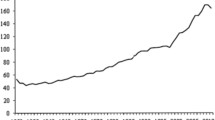Abstract
The decade of the 1970s has seen a major change in the role accorded to monetary policy in the developed countries of the western world. From the final breakdown of the gold standard in the 1930s, and continuing after the Second World War and throughout the 1950s and 1960s, most central banks implemented some form of credit policy. They targetted interest rates and imposed controls over the growth of certain categories of credit, such as bank loans, consumer credit and foreign lending. Broadly speaking these were years of economic stability—most countries experienced a low rate of inflation and a low level of unemployment. By contrast the ’70s have been a period of instability and uncertainty. All western countries have been affected by a high and varying rate of inflation, which has undermined business confidence, and by larger output fluctuations than characterised previous decades.1 In trying to bring this inflation under control, and to achieve greater stability in output growth one country after another has given up controlling interest rates and credit conditions and has adopted quantitative targets for the rate of growth of the money supply as the basis of its monetary policy. The conference on which this volume of papers is based was organised as an attempt to evaluate the experience of various countries in implementing this new form of monetary policy.
Access this chapter
Tax calculation will be finalised at checkout
Purchases are for personal use only
Preview
Unable to display preview. Download preview PDF.
Similar content being viewed by others
Notes
Robert Nozick’s Anarchy, State and Utopia (Oxford: Blackwell, 1974).
John Muth, ‘Rational expectations and the theory of price movements’, Econometrica, 29 (July 1961), 313–35.
Alan Walters, ‘Consistent expectations, lags, and the quantity theory’, Economic Journal, Cambridge, 81 (June 1971).
H. C. Simons, ‘Rules versus authorities in momentary policy’, I.P.E., 44 (1937), 1–30.
Milton Friedman, ‘A Monetary and Fiscal Framework for Economic Stability’, A.E.R., 38 (June 1948), 245–64.
T. Meunch, A. Rolnick, N. Wallace and W. Weiler, ‘Tests for structural change and prediction intervals for the reduced forms of two models of the U.S., the FRB-MIT and Michigan Quarterly Models, Annals of Economic and Social Measurement, 3, No 3 (June 1974), 491–520.
M. J. Beenstock, The Foreign Exchanges: Theory and Policy (London: Macmillan, 1978).
M. Jensen, ‘Capital Markets: Theory and Evidence’, The Bell Journal of Economics and Management Science (Autumn 1972), pp. 357–398.
Editor information
Editors and Affiliations
Copyright information
© 1981 Brian Griffiths and Geoffrey E. Wood
About this chapter
Cite this chapter
Griffiths, B., Wood, G.E. (1981). Introduction. In: Griffiths, B., Wood, G.E. (eds) Monetary Targets. Palgrave Macmillan, London. https://doi.org/10.1007/978-1-349-16555-1_1
Download citation
DOI: https://doi.org/10.1007/978-1-349-16555-1_1
Publisher Name: Palgrave Macmillan, London
Print ISBN: 978-1-349-16557-5
Online ISBN: 978-1-349-16555-1
eBook Packages: Palgrave Economics & Finance CollectionEconomics and Finance (R0)




